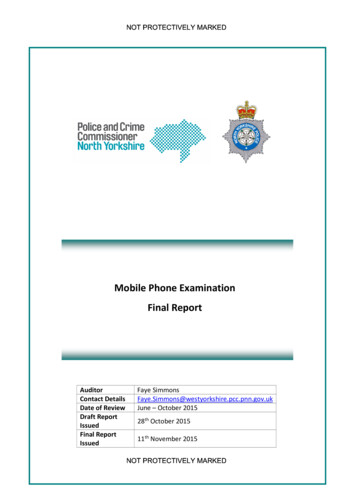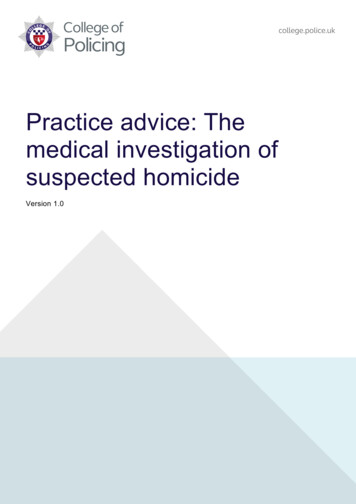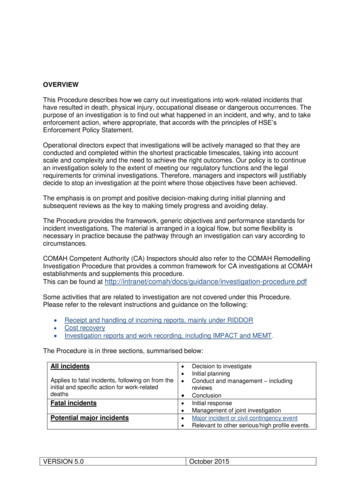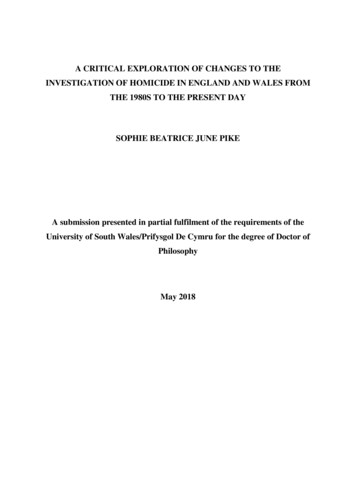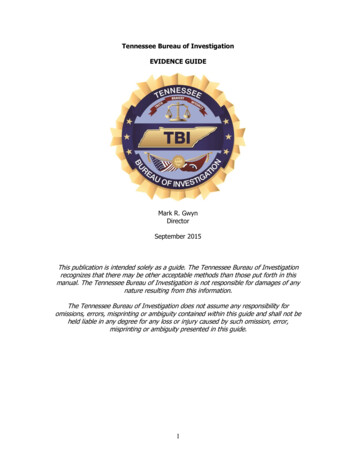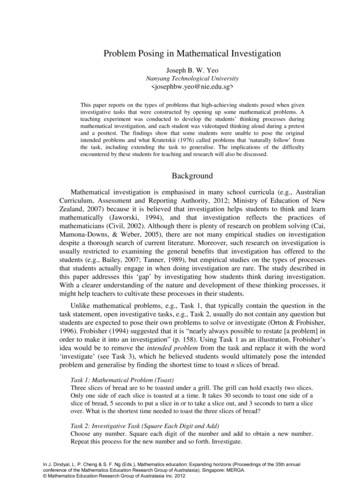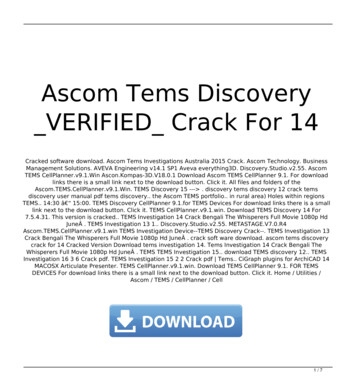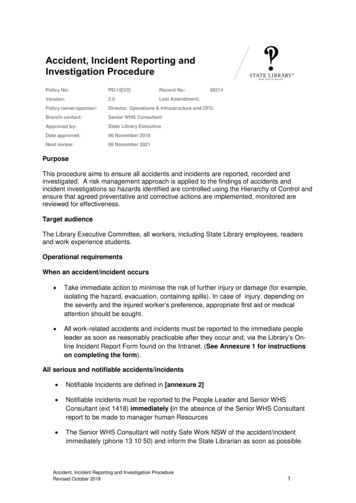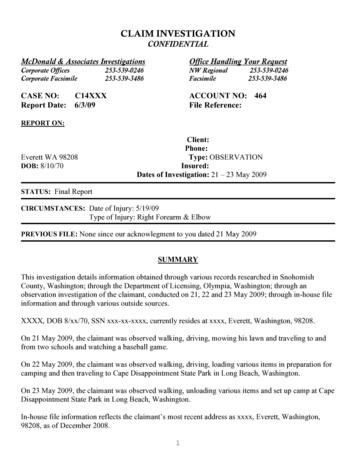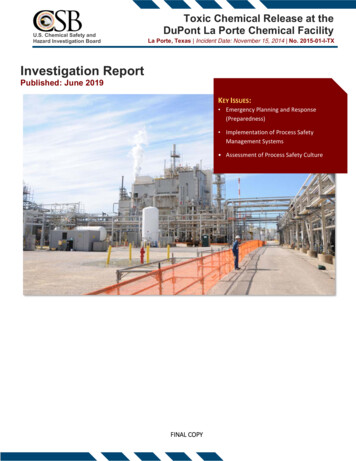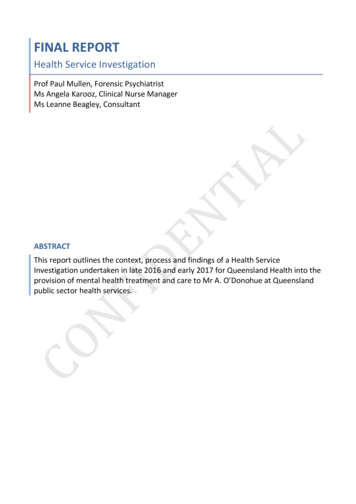
Transcription
FINAL REPORTHealth Service InvestigationProf Paul Mullen, Forensic PsychiatristMs Angela Karooz, Clinical Nurse ManagerMs Leanne Beagley, ConsultantABSTRACTThis report outlines the context, process and findings of a Health ServiceInvestigation undertaken in late 2016 and early 2017 for Queensland Health into theprovision of mental health treatment and care to Mr A. O’Donohue at Queenslandpublic sector health services.
Table of ContentsForward4Executive Summary52 Context for the Review2.1 Background82.2Terms of Reference92.3Conduct of the Investigation102.4Report Outline1112.5 Public mental health service delivery2.5.1 Public Mental Health Service Delivery in Australia2.5.2 The Policy and Service Delivery Framework in Queensland2.5.3 Policies and Procedures – Queensland Health2.5.4 Building on recent developments11111113132.6143Diagnostic ComplexityFindings163.1Statewide service delivery163.23.3The pivotal role of risk assessmentFormulation and treatment planning17193.4 The care journey for Mr O’D3.4.1 Summary3.4.2 Diagnosis3.4.3 Risk Assessment3.4.4 The role of the Community Forensic Outreach Service (CFOS)3.4.5 Risk Management and the use of Involuntary Treatment3.4.6 The clinical decision not to continue with the ITO3.4.7 The use of medication in treatment3.4.8 The clinical decision to use oral rather than depot antipsychotics3.4.9 Psychosocial Rehabilitation3.4.10 Discharge Planning and Closure3.4.11 Re-entry to servicesHealth Service Investigation – January 20172020212123262830303132342
3.53.6The effectiveness of liaison between Hospitals and Health Services36Effectiveness of communication between Queensland Health people and otheragencies.373.7 Compliance with policies3.7.1 Compliance with Clinical and Service Delivery Policies3.7.2 Information Recording Policies3.8 Impact of compliance on care provided383838393.9Summary of Findings41Concluding Remarks4445Appendix List1. Terms of Reference2. Brief Biographies for Health Service Investigators3. References4. Correspondence5. Chronology as required by Terms of Reference 3(c)6. List of documents provided to the Investigation TeamHealth Service Investigation – January 20173
ForwardThe Health Service Investigation (HSI) was set up to review the care received by MrO’Donohue from Queensland mental health services in the context of the terrible incidentthat led to the death of Mr Manmeet Sharma. The HSI panel (the investigators)acknowledges the tragic nature of this event and acknowledges the loss of Mr Sharma tohis family and community.The story of Mr O’Donohue’s treatment and management should not simply be readbackwards with the concluding tragedy providing the prism through which previous eventsare endowed with significance. In drawing conclusions about actions which were, or werenot, taken it should be kept in mind that those responsible for the decisions could onlyoperate on the basis of what was knowable to them at the time. They did not have the benefitof knowing what was to happen. This does not absolve the investigators from the duty tocritically evaluate the care delivered to Mr O’Donohue but it does constrain the investigatorsfrom too readily apportioning blame, if blame there be, without taking full account of whatwas knowable at the time. Occasional failures of communications and infelicities inmanagement are likely to emerge through any careful review of the care and managementof someone who has been a mental health care consumer over many years. Theiridentification may offer the opportunity to improve future procedures and practice. Cautionis, however, advisable when attributing a role to such failings in any unwanted events whichmay later occur.The investigators have identified areas where systems, procedures and practicecould be improved. We often place these factors in the context of potentially improving themanagement and the assessment of the risk of future violent behaviours. This does notamount to identifying any such factors as having contributed to the fatal attack. To reiterate,identifying weaknesses in the system exposed by our enquiry does not of itself propose, letalone establish, a causal link to the killing of Mr Sharma.Clinical decisions are not made in isolation from the influences of the expectations ofthe prevailing culture and service leadership, the clinical evidence base for treatment, thelegal framework, and above all the resources available to accomplish any givenmanagement plan. Health services operate within some degree of constraint created by theavailability of resources. In most health services these constraints include, in addition tohuman resources, the availability of technologies, facilities, and the capacity to provideprocedures and medications. Mental health differs somewhat in that technologies,procedures, and even the availability of the latest and best medications rarely restrict thecapacity to provide services to consumers. The limiting factors are to some extent facilities,in the form of beds, clinics, hostels, and rehabilitation centres, but the most importantconstraint is funding and sustaining a sufficiently numerous skilled, capable and effectivemental health workforce.The investigators appreciated the cooperation we received during the investigationfrom all of those involved.Health Service Investigation – January 20174
1. Executive SummaryThe Health Service Investigation (HSI) was requested following the killing of MrManmeet Sharma allegedly by Mr O’Donohue who had previously been a patient ofQueensland’s mental health services. The investigators examined the quality of the careMr O’Donohue had received over the years 2010 - 2016 to consider processes and revieweffectiveness and ascertain whether this might have influenced the occurrence of the terribleevents of 28th October 2016. Equally important, the question was addressed as to what canbe learned from this case which will reduce the chances of a similar tragedy occurring in thefuture. The report is about a single dreadful event but this must first be considered in awider context.Severe psychotic illnesses are found in between 8% and 12% of homicide offenders,which is some 10 times higher than would be expected by chance. Homicide rightly attractsconsiderable public concern, although it is fortunately a rare offence in Australia, occurringat a rate of less than 2 per 100,000 per annum. The consequences of homicide are,however, so severe for the victims, their friends, their family, and the whole community, thatreducing the frequency of such killings must command a high priority.There is no way that the one individual in every 5,000 people with severe mentalillness who will go on to kill can be reliably identified in advance. What is possible is toidentify factors such as; substance abuse, a disturbed social environment, certain types ofdelusions, and particular personality traits, which are associated with increased rates ofviolent behaviours of all types including, on rare occasions, the murderous. These riskfactors can all, potentially, be managed in a manner which will reduce the chances of futureviolence, through good clinical care and active rehabilitation, rather than by coercion andincarceration. Research has shown that the rates of violence among the seriously mentallyill has not increased from the days when sufferers were locked up in the tens of thousandsin mental asylums.Mr O’Donohue suffers from a delusional disorder characterised by beliefs that he wasbeing persecuted by the trade unions and public servants. He had been reasonablysuccessful professionally, but by the time Mr O’Donohue came to the notice of the mentalhealth services his delusional beliefs had so dominated his thinking that he had beenrendered unemployed, destitute, and homeless. Mr O’Donohue was first admitted in 2010following a suicide attempt. He was re-admitted a year later when he told police he wasafraid he would attack those he believed were persecuting him. Following his discharge onthis occasion Mr O’Donohue was treated in the community, first in the Metro North Hospitaland Health Service (HHS) region of Brisbane, and later in the Metro South Hospital andHealth Service region of Brisbane. In August 2016 he was discharged with a plan for him toreceive the care of a General Practitioner (GP)Delusional disorders are uncommon. They occur in less than 2% of those withpsychotic illnesses. Those with these conditions are difficult to manage as, unlike the morecommon schizophrenias, they only respond partially, at best, to medication and oftenactively resist attempts at treatment and rehabilitation. Managing the risk of violence inthose with delusional disorders is particularly difficult.In 2012 the Community Forensic Outreach Service (CFOS) provided a wellformulated guide to managing Mr O’Donohue’s risk of violence. The responsibility forcarrying through these recommendations fell to the community mental health services, whothe investigators considered probably lacked all the resources, and the necessary depth ofHealth Service Investigation – January 20175
experience, to put these recommendations fully into practice. With the benefit of hindsightit would have been preferable if Mr O’Donohue had been managed with ongoing input fromexperienced forensic mental health clinicians. The situation was not assisted by therecommendations from the CFOS psychiatrist inadvertently not being handed over when MrO’Donohue was transferred from Metro North HHS to the Metro South HHS. This occurredin part because of privacy concerns over forensic assessments. The investigators considerthat this information ought to have been handed over, but note that this has now beenaddressed to prevent any recurrence. The investigators are unable to determine whetherthis would have made any difference to the outcome if the information had been handedover, but given the time period between the hand over between services and the events of2016 it probably did not make a material difference. Perhaps the most important thing toremember was that whatever the limitations may have been in the services Mr O’Donohuewas managed over these years in a manner, which kept him functioning in the communitywithout harming himself or anyone else.Currently Queensland does not have a state wide forensic mental health service ableto offer ongoing care and treatment for consumers who present a significant risk of seriousoffending in the future. Even if such a service had existed, Mr O’Donohue, who did not havea history of offending, nor of overt violence, may not have been seen as a suitable. Forensicservices in other States do, however, often take on consumers with delusional disorders.The attempts to manage Mr O’Donohue’s psychosis and the risks of both suicidaland violent behaviour were repeatedly frustrated by his uncooperative behaviour. Herefused to allow any contact with family, friends, or personal contacts, who might have beenable to provide the all-important background information. He also refused to see a forensicpsychiatrist for assessment; he refused almost all attempts to provide social support andrehabilitation services; he refused referral to a private Medicare funded psychiatrist; and herefused to allow any communications between the community mental health service and theGP who was to undertake his care after he was discharged in 2016; the last probably beingthe most unfortunate. This recalcitrant behaviour and attempts to control the mental healthprofessionals treating them is characteristic of those with delusional disorders.Mr O’Donohue frustrated through his uncooperative behaviour, both his assessmentand treatment which created a difficult dilemma. Mr O’Donohue for much of the time was aninvoluntary consumer, but to use these powers to enforce compliance in a consumer withanything other than medication is difficult and often not in accordance with the relevantlegislation. It is a problem knowing how to strike a balance between the rights of theconsumer and the need to protect those with serious mental illness from harmingthemselves or others. The best solution is not greater coercive powers but having mentalhealth professionals with the time and skills to persuade, or at least wear down theconsumer’s resistance, to what is in their own, and the community’s, best interests.Mr O’Donohue's Involuntary Treatment Order (ITO) was removed in 2014 on thegrounds that he was complying with treatment at least up to the point where he ion.There did not appear to be sound reasons to continue an ITO, and, in fact, Mr O’Donohuecontinued to cooperate, to the extent he ever cooperated, after the ITO ceased.After careful consideration, the investigators consider that based upon theinformation available before the treating team, the actions taken were reasonable withrespect to decisions made relating to involuntary and voluntary treatment.Health Service Investigation – January 20176
The decision to discharge Mr O’Donohue in August 2016 is certainly unfortunategiven what was to occur so soon after, however the investigators were careful to base theirconsideration upon the information available at the time and not rely on hindsight. Thesituation the community team was faced with was a man who had seemed to be reasonablystable, who had not shown much change over the previous year, who was denying he wouldharm himself or others, and for whom they felt they had nothing further to offer. In thesecircumstances to move towards discharge was clinically defensible. Mr O’Donohue did notwish to stop attending the clinic and expressed, and demonstrated, considerable anxietyabout separation. The transfer of his care to a GP did not progress well because the cliniccontinued to acquiesce in Mr O’Donohue’s refusal to allow any communication between theclinic and a GP Mr O’Donohue later attempted to return to treatment at the community clinic.This attempt on his part to gain help failed.While the investigators considered that the decision for discharge was reasonablethey considered that Mr O'Donohue's discharge would have been better managed bymaking full communication with the GP service, to which he was to be transferred, acondition of discharge. The attempt by Mr O’Donohue to return to the community serviceshould have been handled in a manner which at least explored why he was seeking help.These two failures conspired to leave Mr O’Donohue in the community untreated andunsupported.In the light of the deficiencies in the procedures covering Mr O’Donohue’s dischargeand failed attempt to return to care, changes have been made in the guidelines governingboth the process of discharge to GP care, and how to respond to consumers seeking toreturn to care soon after discharge. The investigators support these changes.In cases like this hindsight always allows the identification of moments when haddifferent decisions been made the eventual tragedy might have been avoided. Thosemaking the decisions at the time do not have the benefit of knowing what will happen andhave no alternative but to act on the information available to them at the time. The decisionto terminate Mr O’Donohue’s ITO is entirely defensible, and in any event the investigatorsconsider this had little obvious effect on his subsequent management. The decision todischarge Mr O’Donohue is understandable, but the transfer of care should have been bettermanaged, as should his attempt to re-engage with the service. The assessment andmanagement of risk in Mr O’Donohue is in accord with current practice but was disruptedby his lack of cooperation and, in the view of the investigators, by the absence of a dedicatedcommunity forensic service.This is a tragedy that could not have been predicted. Inevitably, had differentdecisions been made at certain times then the killing might not have occurred. However,the investigators were unable to conclude that any issues identified with respect to handoverof information between services, management of risk, management of the discharge fromthe service in 2016 and handling of the attempt by Mr O'Donohue to re-engage with theservice would necessarily have changed the outcome. That said, there are certainly lessonsto be learned and some of these have already led to changes. The changes made arecommended and endorsed. There are also larger and more complex questions raised abouthow to manage and assess those mental health consumers who may present a risk ofharming others, particularly with regard to how to organise the State’s forensic mental healthservices. There is no silver lining to the tragedy, but it may act as a spur to changes thatwill reduce the chances of a recurrence.Health Service Investigation – January 20177
2 Context for the Review2.1 BackgroundAccording to background briefings provided to the investigators, a bus arrived atIpswich Road, Moorooka bus stop at approximately 9.00 am, Friday, 28 October 2016. MrAnthony O’Donohue entered the front of the bus and allegedly released and ignited aflammable liquid which resulted in a fire on the bus. This action resulted in an on-boardexplosion. Passengers on board had to be evacuated. A 29 year old bus driver, Mr ManmeetSharma was declared deceased at the scene.Health Minister Cameron Dick released the following statement in relation to theincident on 31st October, 2016, announcing the HSI.“Like all Queenslanders, I was shocked to learn of the terrible incident which unfolded inMoorooka on Friday. On behalf of all Queenslanders, I extend my sympathy to the family,friends and colleagues of Mr Sharma, and my thanks to the Queensland AmbulanceService and Queensland Health staff for their swift and effective response to the incident.I am advised by my Department that the accused had previously received public mentalhealth services through the Metro South Hospital and Health Service.Metro South Hospital and Health Service will conduct an internal review of treatment andservices provided to the accused. This is a mandatory process in cases such as this.However, given the very serious nature of this incident I believe it is appropriate that therebe an independent external investigation into the treatment provided within the healthsystem to the accused. Accordingly, I have requested the Director-General of QueenslandHealth to commission an independent investigation under the Hospital and Health BoardsAct 2011 regarding treatment provided to the accused.I am advised Professor Paul Mullen has agreed to conduct this independent health serviceinvestigation. Professor Mullen is one of Australia’s leading forensic psychiatrists. It isexpected that this investigation will be completed within 8 weeks.To the extent possible, any findings and recommendations of this investigation will bereleased publicly.Queensland Health will also assist with any investigation or inquiry conducted by theQueensland Police Service and State Coroner in relation to this incident.As this incident is subject to an ongoing police investigation and is the subject of criminalproceedings before the courts, it would be inappropriate to comment further.”Health Service Investigation – January 20178
2.2 Terms of ReferenceThe Terms Of Reference (TOR) for the HSI are provided at Appendix 1 and theydetail the scope of the investigation, the manner with which it was to be conducted and thenature of the findings to be reported. The scope of the HSI was as follows:1. The Health Service Investigators are to investigate matters relating to themanagement, administration and delivery of public mental health services asprovided to Anthony O’Donohue by the Department of Health and the Hospitaland Health Services particularly Metro South Hospital and Health Services andMetro North Hospital and Health Services. Specifically the Health ServiceInvestigators are to:a. review the patient records for Anthony O’Donohue and any documents,including reports, file notes, and telephone records, whether held onAnthony O’Donohue’s patient record or not, created or received by staff inrelation to Anthony O’Donohue;b. review decisions and actions taken by staff in relation to the treatment andcare of Anthony O’Donohue, particularly including:i. The decision to close his status as an open patient of the PrincessAlexandra Hospital Authorised Mental Health Service in August2016; and,ii. The decision to treat him other than on an involuntary treatmentorder under the Mental Health Act, 2000 (Qld).c. develop a sequence of key events and clinical decision-making pointsrelevant to the clinical management of Anthony O’Donohue’s mentalillness;d. review the admission, examination, assessment, diagnosis, treatment,discharge, post-discharge follow-up and overall management of AnthonyO’Donohue;e. review the effectiveness of liaison between relevant Hospital and HealthServices regarding the assessment, treatment and care for AnthonyO’Donohue including any post-discharge care and follow up arrangements;f. if relevant, review the effectiveness of communication and liaison betweenQueensland Health and other government agencies or other relevantorganisations in respect of Anthony O’Donohue;g. review the compliance or non-compliance with relevant policies andprocedures (including statewide and local) applying in relation to thetreatment and care of Anthony O’Donohue, andh. consider whether the content and level of compliance with existinglegislation, policies and/or procedures had any impact on the standard andquality of care provided to Anthony O’Donohue2. While the treatment and care of Anthony O’Donohue is the focus of the HealthService Investigation, the Health Service Investigators are also to consideridentification of systemic or system-wide issues in relation to the matters outlinedin section 1 above.3. The Health Service Investigators must make findings in respect of the mattersoutlines at 1 and 2 above, in a report under section 199 of the Hospital and HealthBoards Act 2011 (Qld) (HHB Act) regarding,a. the ways in which the management, administration or delivery of the publicsector health services, can be maintained and improved; andb. any other relevant matter identified during the course of the investigation.Health Service Investigation – January 20179
2.3 Conduct of the InvestigationThe HSI panel was appointed in November, 2016 pursuant to Section 190 of the HHBAct and brief biographies of the members can be found at Appendix 2. The investigatorstook a considered and focused approach to the matters specified in the Terms of Reference(TOR), complying with the requirements outlined and delivering findings as articulated. Datainforming the findings included background documentation relating to the patient careprovided, organisational context and structure, governance and service delivery policies. Italso included data generated through in-depth face-to-face interviews with clinicians andleaders of HHSs and through on-site observation undertaken over a five-day period inNovember, 2016. A level of engagement and candor from Queensland Health officers aswell as broad commitment to quality service delivery was observed through the interviewprocess. All interviewees were formally requested to meet with the investigators, providedwith the TOR, invited to bring support with them and advised that there was no guaranteeof confidentiality related to this investigation. All interviews were voice recorded.Additional documents and audits from the CIMHA system were requested during theHSI and were provided to the investigators. A list of relevant documents informing the reportand their source can be found at Appendix 6. Following the interview phase of theinvestigation, the investigators worked together to provide the present report with findingsand concluding remarks. The findings reflect a synthesis of common themes that emergedin this context and across the various data domains. This report represents a synthesis ofopinions of the three Health Service Investigators, which have converged and aligned topresent the final agreed report. Sections of the report and findings that directly relate to eachHHS and its teams have been provided in writing to the HHSs for comment and feedbackprior to finalising the report. The investigators noted the timely, thorough and comprehensiveresponses provided by HHSs through this feedback process, which have been carefullyconsidered in preparing this report.It is important to note that although Mr O’Donohue only became directly engaged withforensic mental health services following the event on 28 October 2016, the structure, roleand opportunities presented by the CFOS were critically important in the review of the careprovided. The findings therefore include comment on opportunities for improvements in thiscritical service delivery arm of Queensland Health. The TOR specifically designated that norecommendations should be made as a result of the HSI, but rather that findings be made.An extensive review of the available literature was neither in scope nor undertaken.Furthermore, the investigation of care provided to Mr O’Donohue was made incontext of the existing legislation at the time that care was provided, that is the Mental HealthAct 2000 (Qld) and policies and procedures in place at the time including the existingstatewide standardised suite of clinical documentation. It is acknowledged that new mentalhealth legislation commences in 2017 (Mental Health Act 2016 (Qld)), which will impact oninvoluntary treatment regimes for patients going forward, and that changes are underway toimprove the clinical documentation suite. The investigators were advised thatimplementation of a statewide Standardised Suite of Clinical Documentation was a keyrecommendation of the “Achieving Balance: Report of the Queensland review of fatalsentinel events: A review of systemic issues within Queensland Mental Health Services2002-2003”. The report was published in 2005. The development of statewide clinicaldocuments was a key recommendation of this report. In early 2016, an Expert Panel ofsenior mental health clinicians reviewed the core suite of clinical documents and made 25broad recommendations for changes to the forms, based on feedback from clinicians,Health Service Investigation – January 201710
targeted literature reviews, and information about clinical documentation used in otherjurisdictions in Australia. The revised forms will be implemented on 5 March 2017.2.4 Report OutlineSection 1 of the report is an Executive Summary of the content of the findingssubsequently detailed. The main body of the report has been structured to provide abackground framework for the review with local and broader policy context seen as animportant foundation for the findings that follow in Section 2. In Section 3 the findings havebeen synthesised and summarised from written documentation provided, data available,observations and the interviews undertaken. In Section 4 some concluding remarks arerecorded, and in section 5 a set of related documents form the Appendices to the report.Given the nature of findings made, feedback in this report has not been attributed toindividuals and to the greatest extent possible has avoided being personally identifyingexcept in relation to the identified patient.2.5 Public Mental Health Service Delivery2.5.1 Public Mental Health Service Delivery in AustraliaState and territory governments fund and deliver public sector mental health servicesthat provide specialist care for people with severe mental illness. These include specialisedmental health care delivered in public acute and psychiatric hospital settings, state andterritory specialised community mental health care services, and state and territoryspecialised residential mental health care services. In addition, states and territories provideother mental health-specific services in community settings such as supportedaccommodation and social housing programs.Mental health related services are provided in Queensland in a variety of ways,including: admitted patient care in hospital and other residential care; hospital basedoutpatient services; community mental health care services; and consultations with bothspecialists and GPs. Access to treatment from psychiatrists, psychologists and other alliedhealth providers may, dependent on eligibility, be provided through Medicare and alsosubsidised through state initiatives to support clients to live well in the community (NationalMental Health Commission, 2014).The key contemporary policy setting in which public mental health services areprovided in Queensland is through a recovery framework defined as follows: “Recoveryfocused services aim to support individuals to come to terms with their illness, learning howto accept and move beyond it. Recovery-oriented services focus on the potential for growthwithin the individual and acknowledge that individuals are active participants on the recoveryprocess” (Connecting Care to Recovery, 2016-2021 Dept Health, 2014).2.5.2 The Policy and Service Delivery Framework in QueenslandIn Queensland, the policy and performance settings are led by the Department ofHealth and sit within a devolved governance structure with HHS. Clinical mental healthservices, delivered through HHS as a program within the acute health care system, areprovided for people with severe and acute mental illness within standardised processes ofassessment including for risk, and for the provision of treatment. Services are provided ona catchment basis and people can refer themselves or be referred by family or anotherHealth Service Investigation – January 201711
service provider for assessment and treatment in the most appropriate setting (inpatient oroutpatient or home based settings) depending on the needs assessment. The newlyreleased Plan for Queensland’s State-funded mental health alcohol and other drug services,Connecting Care to Recovery 2016 sets a future orientati
2.3 Conduct of the Investigation 10 2.4 Report Outline 11 2.5 Public mental health service delivery 11 2.5.1 Public Mental Health Service Delivery in Australia 11 2.5.2 The Policy and Service Delivery Framework in Queensland 11 2.5.3 Policies and Procedures - Queensland Health 13 2.5.4 Building on recent developments 13 2.6 Diagnostic .

